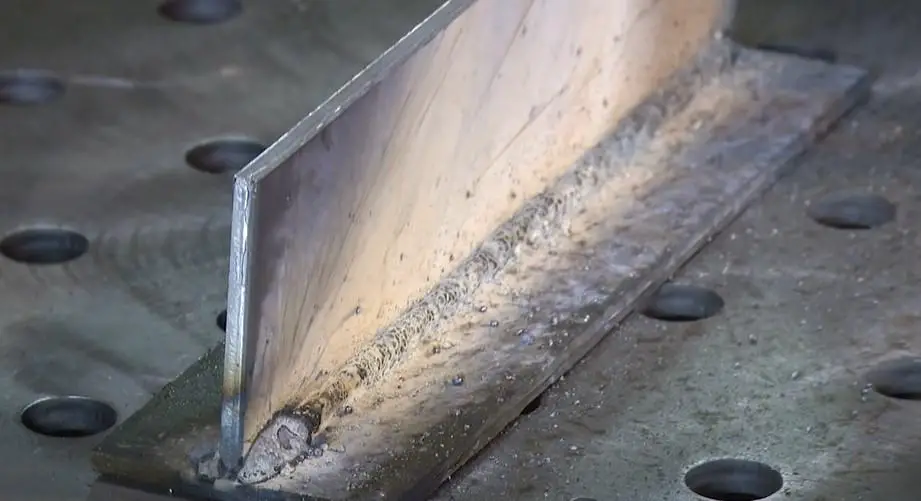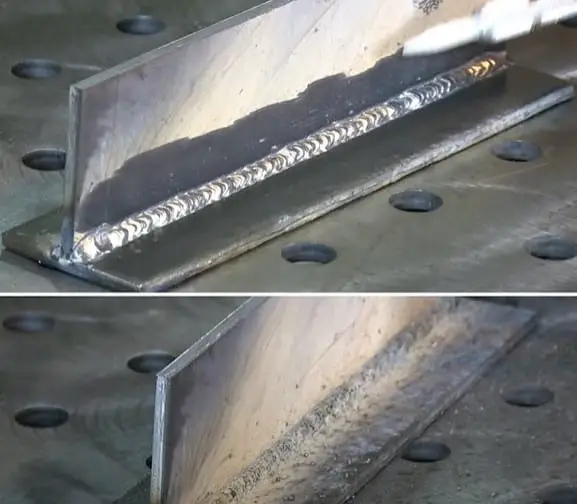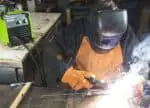The spattering of the molten welding metal.
The most annoying and troublesome thing about MIG welding.
 Those who are into welding for sure will be aware of how dangerous and distracting this can be. So how can one limit this? Is it possible to completely get rid of this?
Those who are into welding for sure will be aware of how dangerous and distracting this can be. So how can one limit this? Is it possible to completely get rid of this?
This article can give you an idea about all these…
The spattering of MIG welding can definitely be reduced. However, molten metal getting spattered can be reduced only after knowing what causes this and why it happens. There are several ways through which the spattering of weld can be reduced.
So, what is weld spattering exactly?
Of course, this is something that anyone can tell. We have seen it many times whether we are working in the field of construction or not. The sparks that arise while the electricity passes and the electrodes take charge is what is called spatter. So what are these sparks?
Sparks are nothing but the droplets of molten metal. And if touched, these sparks can cause injuries and damage your skin. But, the problem is spattering is a part that is critical to welding. It fully can’t be gotten rid of but its intensity can be reduced.
What is the need to reduce weld spatter?
As mentioned in the previous paragraph, the spattering of molten metal can harm your skin or any other body part if you are not careful enough. But there are also other reasons why spattering of the weld is considered a nuisance:
1.) Loss of material from the weld and arc: This is pretty an obvious fact. As the spatter consists of droplets of molten metal, the more intensely it happens, the more metal you lose. Material from weld and arc are wasted in this form.
2.) Sticking of spatter balls: This happens because these balls are molten metals and they tend to stick to wherever they touch. So it is extremely important to see that these dots are not anywhere near your naked skin. Carelessness can cost you a lot when it comes to an intense process like welding.
3.) Clean-up: Of course, an extensive clean-up becomes necessary after the process due to spatter. And this clean-up will definitely not be a piece of cake.
You have to spend considerable time and energy to remove the small dots that are scattered. There are numerous ways to remove these spatter stains which will be discussed later in this article
How to reduce spattering in MIG welding?
Ways to reduce spatter in the weld are numerous and you can find them below:
1. Ensure proper settings in MIG welder
As mentioned in the reasons, the equipment needs to be prompt when it comes to the settings. In MIG welding, the current and voltage need to be set according to the welding that needs to be done.
Being too fast and too slow should be avoided. Avoid low voltage and high amperage a sit can result in a high level of spattering. The heat should be ideal enough for the electrode to take charge.
2. Choose the right gas
Yes, the shielding gas chosen should be the one that created fewer spatters or can counter the spatter created by another gas that is used.
The right gas for the type of welding is necessary to have a smooth welding process. The even distribution of the gas blanket is also an important aspect to keep spattering at bay.
3. Stable ground clamps
For a welding process to work as you desire with less trouble the whole system should be stable. Unstable ground clamps are therefore the main reason that causes spatter of the weld. So the whole setup should be stable enough to keep the work intact.
4. Remove all the layers dirt on metal
Yes, you have to remove all the layers of dirt and contamination at least to a quarter of the metal in whichever way possible. Try to keep the metal as clean as possible for a reduced spatter experience.
5. Use high quality welding metal, wires, gas and intruments
Whether it is the welding metal or the wires used or even the other instruments used for welding, do not compromise on quality as the spattering depends hugely on the quality.
Even the shielding gas quality is important to keep spattering at bay. The intensity of spattering and quality of the instruments is therefore inversely related.
6. An eye on the stick-out
The electric stick out or the distance between the contact tip to the workpiece shall be maintained as quarter length for the spatter of weld to be kept at bay.
7. Maintain the correct angle
Earlier you saw how the wrong angel of holding the gun can create a lot of spatter. So, what is the right angle to be maintained? You should be vigilant enough to keep the working angle at 15 degrees. The less steep, the lesser will be the spatter.
8. Spray transfer
As a solution to the metal transfer mode mentioned in the above section, one can do is to have a spray transfer where argon gas of a minimum of 83% shall be included in the welding mix.
9. Continuity in feeding
The feeding speed shall not fluctuate reflecting the same in the amperage. This helps to reduce spattering to an extent.
See also: How to remove weld spatter from stainless steel
Why spattering in MIG weld happens?
Now you know what is spatter and how it can be a problem for you but why does it happen? Let’s see…
There are various reasons for this to happen:
1.) Disturbance of weld pool: A major reason is a difference in the connection between voltage and amperage. This causes disturbance in the wire being transferred into the weld. Two instances can arise: voltage for welding will be too low or the amperage voltage will be high for the particular combination of gas and wire.
Each element should be in the same range of voltage for a smooth welding process. If the arc is not hot enough then the weld and pool can’t be kept molten and this results in a disturbance with the wire being transferred resulting in spatter. This situation can happen in both low and high current.
2.) Choosing the right welding gas: the intensity of spatter also depends on the gas you chose to assist you in the welding process. It is a widely known fact that carbon dioxide causes a lot of spatter in weld and argon gas is used to counter this.
3.) Filler and metal: Another thing that causes spatter is the metal you choose. Yes, they can give you trouble depending upon how much it needs to be filled. The cheaper the metal is, the more filling you need to do.
And the more you do the filling; the chances of spattering will also be high. So, better the metals are of good quality, so that you don’t have to spend much time filling and can finish your job smoothly.
4.) Contamination and dirt: Dirt or contamination can increase the spatter of the weld. Contamination can be the coating of metal or oil on it. Even though the penetration of the electrode is possible, the spattering might be more due to these elements.
5.) Settings: The welder equipment used shall be adjusted based on the type of work. You can’t go too fast nor too slow while using these devices. Spattering can be the result in both cases.
If you are too fast you might push the metal wire into the weld pool and if you are too slow then the wire can get vaporized before getting it into the weld.
6.) Angle: The angle with which you are holding the gun matters a lot in controlling the spatter. There are certain things that you need to make sure to prevent the spattering from happening depending on the position held.
7.) Metal transfer mode: Certain modes of metal transfer creates spatter. This includes short arc and globular transfer. Fortunately, it is possible to drastically reduce this spatter through certain steps.
8.) Instability: An erratic feeding, unstable ground or any other element that is not strong enough can cause spatter easily. Measurements are important. Amount of everything including the shielding gas matters.
Apart from these, there are also other instances where spatter happens but in quite a different form:
-
-
- Contact between the weld droplets and weld pool can cause splashing of the molten weld.
- A repulsion force of the arc can cause the weld bead to break off and scatter.
- A sudden increase in current can make it go beyond the capacity of welding wire which can lead to what welders call “arc explosion” which results in spatter.
-
What are the different methods to clean weld spatter?
1.) Chisel: This is an apt tool to remove the spatter from sticking. Once the spatter is stuck you cannot remove it from the surface unless and until you use force. Holding the chisel where the spatter is and using a hammer to tap it at the end in the needed force can help to slowly remove the spatter.
Depending on how stubborn and entrenched the spatter is, you will have to decide the force and the number of taps required to clean it. Do not forget to be careful of the sharp broken parts of spatter hitting your skin or eyes. Wear a protective cover over your eyes to prevent such accidents.

2.) Flap disc: Flap disc at the angle grinder is one of the effective methods to remove the stuck spatter. As the angle grinder is a machine you do not need to give effort from your side to push the spatter from its place. Once the machine is switched on, the rest will be taken care of by the flap disc itself.
You need to keep an eye on how the process will not harm the surface that you are working on. These sharp tools can easily disfigure any area and you also need to be careful in deciding while handling it for your own safety.
3.) Grinding: Here, the same companion is required: angle grinder. But, instead of a flap disc, you use a grinder. A grinder is much more powerful and strong that it can be used to remove medium and large spatter.
The bigger the spatter of the weld is, the more will be the debris piled after it. So, after the removal process, you need to gently sweep it off without scratching the surface.
Can I prevent weld spatter from sticking?
A method different from those mentioned above, the use of anti-spatter spray is much more beneficial as the spatter will not get stuck to a surface where this liquid has been sprayed. It prevents the adhesion of spatter to the welding pieces and nozzles.
It prevents the workpieces from sticking unnecessarily resulting from the weld splashes. You can buy the anti-spatter spray of your choice depending upon the work you do from the market.
But not every method is error-free. Anti–spatter spray can also at times be not effective as the weld fixtures might create obstacles, if not eventually then initially. Sometimes you will need to wash off the oily substances along with the adhered weld spatter.
Yes, weld spatters might get stuck to the anti-spatter spray build-up. Removing all these together can create an even problematic situation than the normal weld spatter.
So what is the ultimate solution?
Using a permanent coating technology.
Yes. This permanent coating after being applied to the welding fixtures is treated at high temperatures. Once it is completely dried, you do not need an anti-spatter spray or any other tools as the sticking of weld spatter will be a problem of the past.
This technique has numerous advantages as it prevents a lot of post welding problems. It gives a better satisfaction to the welder as he does not have to give extra care removing the stuck spatter, always being vigilant not to harm or scratch the surface. Therefore, this technology guarantees better quality work.
With modern technology and sophisticated welders, spatters are almost not a problem these days. However, as time passes by and the machines are worn out, spatter becomes a prominent problem while welding. Now that you know how to prevent them, you can find the best method the next time you weld to escape from the trouble!
For more such informative articles visit our other blogs!







